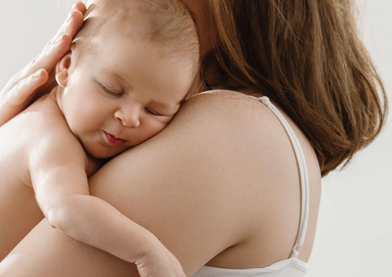Dry skin conditions are common in babies and often, dry skin on your baby will clear up on their own. Sometimes though, it can cause an ongoing problem. Baby dry skin can be caused by many factors, such as genetics, the age of the baby, or allergic reactions.
Here, we’ll give you some tips on how to identify dry skin on your baby, the possible causes, and how to look after it, including bathing and cleansing.
Symptoms of baby dry skin
Here are some of the signs of baby dry skin:
Skin that is peeling or flaking
Cracked skin
Itching
Redness
Rough, grey, and ashy patches of skin.
Newborn flaky skin is normal: it often happens when a baby is overdue. This should clear up within the first few weeks, and the skin below will be soft and healthy.
Some babies will experience continued dry skin and even develop conditions like eczema, also known as atopic dermatitis. Eczema typically shows up as patches of dry skin on a baby’s face, and creases in the knees and elbows. It’s usually red, but on darker skin, the patches can look more purple, brown, or grey.
Causes of dry skin on a baby
After birth, your baby’s skin has to shift from the womb, which is surrounded by water, to the dry atmosphere. They also have to get used to wearing clothes and being washed. This process could be tough, meaning that often, they can have peeling, dry patches of skin.
The common causes associated with baby dry skin and newborn dry skin are:
Low humidity – especially during winter when you’re more likely to dry out the air in your home by using central heating.
Age – it’s common for newborns to have dry skin, but if it doesn’t improve, talk to your GP.
The seasons – sensitivity to cold winds or extreme heat can cause dryness in the skin.
Soaps – chemicals in soaps and detergents can irritate your baby’s skin and dry it out.
Allergens – pet hairs, dust, or cigarette smoke can irritate and dry out the skin.
Genetics – dry skin conditions, such as eczema, can run in families.
Overbathing – can dry your baby’s skin out as it washes away the natural oils on the skin’s surface, causing dryness.
How do I identify the cause of my baby’s dry skin?
If you’re not sure what could be causing flare-ups of dry skin on your baby, try keeping a log of whenever their skin seems dry. This may help you spot potential patterns to work out what might be behind the issue.
If your baby has skin that is inflamed, crusty, broken, weeping, or blistered, it’s best to consult a medical expert.
Treating baby dry skin
Remember, baby skin is thinner and more delicate than ours, so specially formulated infant products should be used on it11. Here are some of our top tips for dealing with baby dry skin at home:
Bathing
Babies don’t tend to do very much, which typically means they don’t need a full bath every day. Instead, you can try topping and tailing them to keep their face and bottom clean without giving them a full bath.
When you do, avoid using products that dry their skin and instead, choose specially formulated products for babies and infants that are more delicate on their skin.
Use the right laundry products
Ideally, you should wash baby clothes with ‘non-biological’ detergents and rinse them thoroughly afterwards to help minimise issues with baby dry skin. Gentle fabric conditioners may also help keep their clothes nice and soft to help prevent itching.
Limit the amount of product you use
You don’t necessarily need to put anything on dry skin to help treat it – it may heal itself in time. If it doesn’t, or you have concerns, you can talk to your pharmacist.
Try to limit the number of products you use on their skin, as this could increase the risk of it drying out. You should also avoid leaving your baby in the sun without sun protection or a proper covering.
A gentle moisturising lotion can be used on dry baby skin after bathing to keep their skin soft if needed. You can also use a type of moisturising cream known as an emollient or baby face cream to help relieve dry skin on your baby’s face.
For more information on baby skin care routines, take a look at our baby skincare guide.

